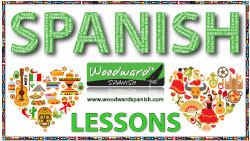How to use the Santiago Bus System
Santiago - Chile
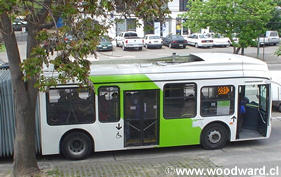
Taking a bus in Santiago can be a bit of an adventure in itself. The following guide is to help people new to the city learn how to use this form of transport.
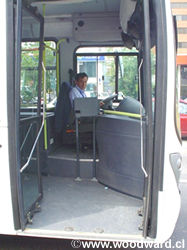
How much does it cost and how do I pay?
In Chile there is only one fare you have to pay (which varies from city to city) to get on a bus. You can travel only one block or across the entire city for the same price.
In Santiago you will need to use the BIP card to pay it. This is a card that you swipe past a special machine that reads a chip in it and deducts the appropriate amount each time you get on a bus (it's NOT a day pass). The same card is used for the metro (subway) too. You can buy these BIP cards at any metro station, though without any credit on it. You will have to add some money on to it the first time so you can start to use it and then you can then keep topping the cards up as often as you like.
Note: You can change buses without being charged an extra fare up to two hours after the first fare was charged. Also if you jump on the metro (subway) in that same time, you will only be charged the difference, not the full fare.
The government tried to make some automatic coin operated machines compulsory a couple of years ago though they came across heated opposition from the bus owners and the public in general. Some 'micros' still have these machines though they cannot be used.
You may see a fare which is for students. This is not for international students, only local students studying full-time in Chile with a special card (that has a photo) given by the Government.
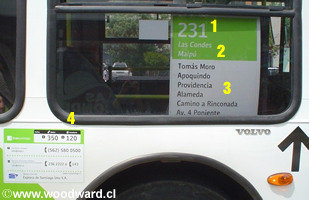
How to know which bus to use.
1. This is the bus number
2. The starting destination and the final destination. It usually refers to the suburb.
3. The main streets the bus goes along.
4. The bus fare
In the photo above, you will see that the bus started in the Las Condes suburb and will end up in the Maipú suburb. It starts by going along the residential street of Tomás Moro then goes onto Apoquindo (which happens to be where Woodward Chile was), then Providencia (a shopping / business area) and then Alameda which is downtown. From there is goes to Camino a Rinconada and then Av. 4 Poniente. There will of course be more smaller streets at the beginning and end of the run though they are not normally placed on the destinations chart in the window.
The main street that cuts through the middle of the city from East to West changes its name a number of times. It starts off as Av. Las Condes, then becomes Av. Apoquindo then Providencia and then Alameda.
These buses won't take you to the airport since it is well outside of the city. Even though there are a couple of buses that have the word aeropuerto (or airport) in the main streets section of their sign, it is only the name of a street and won't take you anywhere near where you really want to go.

Many people will just tell you the bus number to take to get to a certain destination. Make sure you take it on the correct
side of the street otherwise you will end up on the opposite of the city. Ask the driver if the bus takes you to a
certain street if you are not sure.
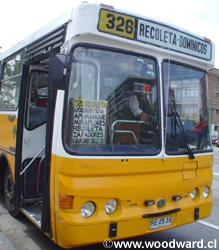
A few years ago you used to see the infamous yellow buses in Santiago. These have now been replaced by the more "efficient" green and white buses in a governmental plan called 'Transantiago'.
The drivers now receive a fixed salary so their need to rush everywhere to try and beat the other drivers to their clients no longer happens. In the past, the yellow bus drivers only received a small (I would say more like insignificant) percentage of tickets sold which of course is why many drivers would pocket the fare money without giving the ticket and race each other to get to the clients first.
You should get on a bus at a bus stop as now as, unlike the past, you cannot wave them down on the street. To get off the bus, it pays to push the stop button or pull a cord going along the roof before you intend to stop since Micros are notorious for travelling very fast and may not stop in time at where you want. Bus drivers are famous for NOT respecting other traffic and for racing along streets. If you have been in Santiago for a while you can guarantee that at some moment you will have been in some type of 'accident' where the bus hits/nudges/scrapes along/bumps into/crashes into/runs over some other vehicle or thing or whatever. I personally have witnessed many including people getting run over.
With the Transantiago Plan, they hoped to improve this situation. There are still problems with this now-not-so-new system since many of the older yellow buses with their routes were taken off the map leaving many people unhappy. Little by little it gets better.
Entertainment and Food on the Bus ???
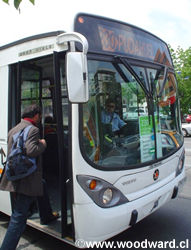
While you are on the 'micro', you will see a variety of characters rapidly getting on and off the bus. They include people selling sweets, chocolate or some other food "A CIEN" which means for 100 pesos. Other times you will see people selling bottles of drinks, children's colouring books, socks, a set of kitchen knives or whatever they feel that the people need. Some times you will see people come on dressed as clowns and telling jokes, other times with a guitar or bongo drums to entertain the crowd (some are really good). Every now and then someone may come on and leave a card with a calendar on it on your lap (whether you asked for it or not). They are not for free so if you don't want it just hand it back or if you do want it, hand over some coins. In some cases you will get someone coming on telling a long story (obviously in Spanish) about how their child is sick and they lost their job and are looking for some coins that may help ease their suffering. Though occasionally their story may be true, often it is not. Many people do this as their 'profession' which seems to pay quite well. They will even go to falsifying documents to make it appear more real. I remember a case where a lady sitting in front of me (who said she was a doctor) offered to help the child where she worked. The woman with the supposed sick child wasn't interested in her help; she just wanted the money then and there. Something to think about!
La Micro
La Micro = this is what the local buses within a city are called.
- Voy a tomar la micro en la esquina. (I'm going to take the bus on the corner)
NOTE: You need to be careful because even though the word ends in 'o', it is a feminine word.
If you found this guide about Chile interesting or useful, let others know about it.

